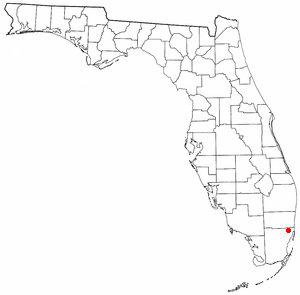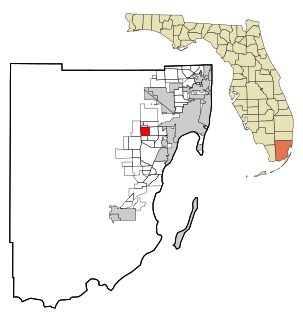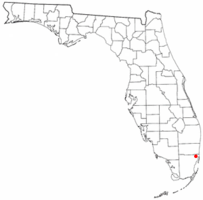
Pembroke Park is a town in Broward County, Florida, United States. The town took its name from its location along Pembroke Road. As of the 2020 census, the population was 6,260. It is part of the South Florida metropolitan area, which was home to 5,564,635 people at the 2010 census. Almost one-half of its residents live in mobile homes.

Carol City is a neighborhood in Miami Gardens, Florida, United States. The population was 61,233 at the 2010 census. It was formerly a census-designated place.

Country Club is a census-designated place and a suburban unincorporated community located in northwest Miami-Dade County, Florida, United States. It is named after the Country Club of Miami, which was established in 1961 in what was then an unpopulated and undeveloped section of the county. The population was 36,310 at the 2000 census.

Fontainebleau is a census-designated place (CDP) in Miami-Dade County, Florida, United States. The population was 59,870 during the 2020 census.

Golden Glades is a census-designated place (CDP) in Miami-Dade County, Florida, United States. The population was 32,499 at the 2020 census.

Kendall is a census-designated place in Miami-Dade County, Florida, United States. At the 2010 census, the area had a population of 75,371.

Leisure City is a census-designated place (CDP) in Miami-Dade County, Florida, United States, that includes the smaller, older community of Modello in its northwestern section. The population was 22,152 at the 2000 census. Leisure City is most notable for the Coral Castle Museum, located in the Modello area.

Miami Springs is a city located in Miami-Dade County, Florida. The city was founded by Glenn Hammond Curtiss, "The Father of Naval Aviation", and James Bright, during the famous "land boom" of the 1920s and was originally named Country Club Estates. It, along with other cities in Miami-Dade County such as Coral Gables, Florida, and Opa-locka, Florida, formed some of the first planned communities in the state. Like its counterparts, the city had an intended theme which in its case, was to reflect a particular architecture and ambiance.

Ojus is a census-designated place and formerly incorporated town in Miami-Dade County, Florida, United States. The population was 16,642 at the 2000 census. Ojus is bordered by Aventura to the east, I-95 to the west, North Miami Beach to the south and Broward County to the north.

Olympia Heights is a neighborhood in Miami-Dade County, Florida, United States. The population was 13,488 at the 2010 census.

Opa-locka is a city located in Miami-Dade County, Florida, United States. As of the 2010 U.S. Census, the population was 15,219. The city was developed by Glenn Curtiss. Developed based on a One Thousand and One Nights theme, Opa-locka has the largest collection of Moorish Revival architecture in the Western Hemisphere, and streets with such names as Sharazad Boulevard, Sinbad Avenue, Sabur Lane, Sultan Avenue, Ali Baba Avenue, Perviz Avenue, and Sesame Street. Opa-locka has an area of 4.2 square miles and is located in the northwestern area of Miami-Dade County, Florida.

Opa-locka North is a neighborhood in Miami Gardens, Florida, United States. It was formerly a census-designated place. The population was 6,224 at the 2000 census.

Richmond Heights is a census-designated place (CDP) in Miami-Dade County, Florida, United States. The population was 8,541 at the 2010 census.

Tamiami is a census-designated place (CDP) in Miami-Dade County, Florida, United States. The population was 55,271 at the 2010 census.

The Hammocks is an unincorporated census-designated place in Miami-Dade County, Florida, United States. The population was 51,003 at the 2010 census.

University Park is a census-designated place (CDP) and neighborhood in Miami-Dade County, Florida, United States. The population was 26,995. It encompasses the Modesto A. Maidique Campus of Florida International University.

Virginia Gardens is a village in Miami-Dade County, Florida, United States. According to the U.S. Census Bureau, the village had a population of 2,375 in 2010.

West Little River is a census-designated place (CDP) in Miami-Dade County, Florida, United States. The population was 34,699 at the 2010 census.

Westchester is a census-designated place (CDP) and neighborhood in Miami-Dade County, Florida, United States. The population was 29,778 at the 2020 cencus.

Miami Gardens is a city in north-central Miami-Dade County, Florida, United States. It is 16 miles north of Downtown Miami and its boundaries stretch from I-95 and NE 2nd Avenue on the east to NW 47th and NW 57th Avenues on the west, and from the Broward County line on the north to 151st Street on the south. The city name comes from one of the major roadways through the area, Miami Gardens Drive. According the US Census Bureau, the city had a population of 110,001 as of 2019, and it is Florida's largest city with a majority African American population. It is a principal city of the Miami metropolitan area, which was home to an estimated 6,012,331 people in 2015.




















